UNITED STATES
SECURITIES AND EXCHANGE COMMISSION
WASHINGTON, D.C. 20549
FORM 8-K
CURRENT REPORT
Pursuant to Section 13 or 15(d)
of the Securities Exchange Act of 1934
Date of Report (Date of earliest event reported): December 8, 2023
bluebird bio, Inc.
(Exact name of Registrant as Specified in Its Charter)
| Delaware | 001-35966 | 13-3680878 | ||
| (State or Other Jurisdiction of Incorporation) |
(Commission File Number) |
(IRS Employer Identification No.) |
| 455 Grand Union Boulevard, Somerville, MA |
02145 | |
| (Address of Principal Executive Offices) | (Zip Code) |
(339) 499-9300
(Registrant’s telephone number, including area code)
Not Applicable
(Former Name or Former Address, if Changed Since Last Report)
Check the appropriate box below if the Form 8-K filing is intended to simultaneously satisfy the filing obligation of the registrant under any of the following provisions (see General Instructions A.2. below):
| ☐ | Written communications pursuant to Rule 425 under the Securities Act (17 CFR 230.425) |
| ☐ | Soliciting material pursuant to Rule 14a-12 under the Exchange Act (17 CFR 240.14a-12) |
| ☐ | Pre-commencement communications pursuant to Rule 14d-2(b) under the Exchange Act (17 CFR 240.14d-2(b)) |
| ☐ | Pre-commencement communications pursuant to Rule 13e-4(c) under the Exchange Act (17 CFR 240.13e-4(c)) |
Securities registered pursuant to Section 12(b) of the Act:
| Title of each class |
Trading |
Name of each exchange |
||
| Common Stock, $0.01 par value per share | BLUE | The Nasdaq Stock Market LLC |
Indicate by check mark whether the registrant is an emerging growth company as defined in Rule 405 of the Securities Act of 1933 (§230.405 of this chapter) or Rule 12b-2 of the Securities Exchange Act of 1934 (§240.12b-2 of this chapter).
Emerging growth company ☐
If an emerging growth company, indicate by check mark if the registrant has elected not to use the extended transition period for complying with any new or revised financial accounting standards provided pursuant to Section 13(a) of the Exchange Act. ☐
| Item 7.01 | Regulation FD Disclosure. |
On December 8, 2023, bluebird bio, Inc. (the “Company”) held a conference call and audio webcast at 4:15 p.m. Eastern Time (“Investor Call”), during which it discussed the approval of LYFGENIA (lovotibeglogene autotemcel), also known as lovo-cel, and its plans for commercial launch. During the Investor Call, the Company provided an investor presentation, dated December 8, 2023, a copy of which is attached as Exhibit 99.1 to this Current Report on Form 8-K (this “Current Report”) and incorporated herein by reference.
The information in Item 7.01 of this Current Report is intended to be furnished and shall not be deemed “filed” for purposes of Section 18 of the Securities Exchange Act of 1934, as amended (the “Exchange Act”), or otherwise subject to the liabilities of that section, nor shall it be deemed incorporated by reference in any filing under the Securities Act of 1933, as amended, or the Exchange Act, except as expressly set forth by specific reference in such filing.
| Item 8.01 | Other Events. |
LYFGENIA (lovo-cel) Approval
On December 8, 2023, the Company announced that the U.S. Food and Drug Administration (the “FDA”) approved LYFGENIA (lovotibeglogene autotemcel), also known as lovo-cel, an autologous hematopoietic stem cell-based gene therapy indicated for the treatment of patients 12 years of age or older with sickle cell disease (“SCD”) and a history of vaso-occlusive events (“VOEs”). The LYFGENIA product label includes a boxed warning for the risk of hematologic malignancy.
LYFGENIA is expected to be available through the Company’s network of qualified treatment centers (“QTCs”) beginning in the first quarter of 2024. The Company estimates that there are more than 20,000 individuals in the United States with SCD that may be addressed by gene therapy. At the time of approval, 27 QTCs are ready to receive patient referrals and the Company anticipates a QTC network of 40 or more QTCs to be fully activated for LYFGENIA patients by the end of the first quarter of 2024. The Company estimates that approximately 60% of SCD patients live within 50 miles of a planned QTC and 95% of SCD patients live within 200 miles of a planned QTC.
Following cell collection, a LYFGENIA patient’s cells are shipped to a manufacturing facility where they are transduced with the appropriate lentiviral vector, formulated and frozen. Samples of the transduced cells are tested to ensure they meet stringent release specification criteria, after which LYFGENIA is shipped back to the QTC where the patient receives treatment via intravenous infusion. The process is designed to take between 70-105 days from apheresis (cell collection) to the time that manufactured drug product is ready to be shipped back to the QTC for patient infusion.
The Company has set a wholesale acquisition cost of LYFGENIA in the United States at $3.1 million. To support timely and equitable access, the Company has designed outcomes-based contract options unique to LYFGENIA that are designed to offer payers meaningful risk sharing tied to VOE-related hospitalizations—a claims-based metric that is directly correlated with clinical benefit and aligned with study endpoints in the LYFGENIA clinical development program—with patients followed for three years. As of December 8, 2023, the Company was in advanced discussions regarding reimbursement for LYFGENIA with the nation’s largest commercial payers and more than 15 Medicaid agencies representing 80% of individuals with SCD in the United States.
Clinical Data Updates
In addition, the Company announced the following updates to its clinical data that were presented at the American Society of Hematology Annual Meeting & Exposition:
LYFGENIA (lovo-cel)
The Company presented the following efficacy, safety and health-related quality of life data (“HRQoL”) from the Phase 1/2 HGB-206 Group C and Phase 3 HGB-210 studies through five years of follow-up (median 35.5 months, range 0.3-61 months). As of the cut-off date of February 13, 2023, 34 of the 47 patients treated in HGB-206 Group C and HGB-210 were evaluable for the primary and secondary endpoints of complete resolution of VOEs and severe VOEs (“sVOEs”) with a median (min, max) follow-up 36.3 months (12.1, 61).
| • | 32/34 patients (94%) experienced complete resolution of sVOEs, maintained for a median of 35.8 months (20.2, 61). |
| • | 30/34 patients (88.2%) experienced complete resolution of all VOEs, maintained for a median of 35.8 months (20.2, 61). |
| • | Patients who experienced VOEs at any time post-treatment through long-term follow-up (n=8) experienced significant reduction in VOE frequency and severity compared to before treatment. |
| • | All 8 patients experienced a reduction in VOEs of at least 50%. |
| • | Hospital days and admissions were reduced by as much as 100% (annualized median hospital days reduced from 15.75 (3.5, 136) pre-treatment to 2.20 (0.0, 25.4)); (annualized median reduction in hospital days was 85.5% (31.7%, 100%)). |
| • | Results of a sub-analysis of data from adolescent patients, presented for the first time, showed complete resolution of VOEs and sVOEs in 10/10 (100%) patients during the 6-18 month assessment period. |
With the exception of patients with alpha-thalassemia trait, all patients had improvement in total hemoglobin and markers of hemolysis; improvements were sustained through last follow-up. As of the February 13, 2023 cut-off date:
| • | Following engraftment, non-transfused total Hb and %Hb fractions stabilized by approximately six months after lovo-cel infusion. |
| • | Median percent of gene-therapy derived anti-sickling adult hemoglobin (HbAT87Q) was maintained generally at >40% of non-transfused total Hb throughout follow-up. |
| • | From six months post-infusion through the last visit, several indicators of the health of red blood cells suggest that treatment with lovo-cel improved biological markers for SCD to normal or near-normal levels. Lactate dehydrogenase and indirect bilirubin levels normalized and reticulocyte counts approached normal levels. |
HRQoL findings in patients treated in HGB-206 Group C were generated using the Patient Reported Outcomes Measurement Information System 57, a validated instrument in SCD. Improvements in key domains including pain interference, pain intensity, and fatigue were demonstrated, showing statistically significant improvements as early as month six which were sustained up to 36 months for pain intensity and 48 months for pain interference and fatigue.
The majority of adverse events (“AEs”) in patients treated in HGB-206 Group C and HGB-210 were attributed to underlying SCD or conditioning with busulfan. Nonserious AEs related to lovo-cel included infusion reactions (abdominal discomfort, decreased diastolic blood pressure, and nasal congestion), each in one patient (2.1% each). Serious AEs (“SAEs”) related to lovo-cel were reported in two patients with comorbid alpha-thalassemia trait and they included two SAEs each of anemia (4.3%) and one SAE of myelodysplastic syndrome (2.1%), the diagnosis of which remains under evaluation. One patient died due to sudden cardiac death which was deemed unrelated to lovo-cel.
As previously reported, cases of acute myeloid leukemia were observed in two patients from the HGB-206 Group A cohort who were treated with an earlier version of the therapy prior to enhancements to the treatment and manufacturing processes. Both patients died due to aforementioned leukemia.
No graft failure, replication-competent lentivirus or vector-mediated insertional oncogenesis was observed across the entire clinical development program.
ZYNTEGLO (beti-cel)
In addition, the Company presented updated data from its gene therapy program in transfusion-dependent beta-thalassemia. As of the cut-off date of January 30, 2023, among patients in the Phase 3 studies, 90.2% (37/41) achieved transfusion independence (“TI”). As of the cut-off date, TI was maintained through last follow-up (up to six years) across ages and genotypes. Among patients in the Phase 1/2 studies, 68.2% (15/22) achieved TI, with 14 patients sustaining TI through the last follow-up (up to nine years). One patient, with human immunodeficiency virus complicated by gastrointestinal infection and bleeding, no longer met protocol-defined TI as a result of a hemoglobin level <9 g/dL at year six. The patient continued to benefit from beti-cel therapy and was not receiving chronic red blood cells transfusions as of the last follow-up.
Among 12 adult patients and 22 pediatric patients in the Phase 1/2 and Phase 3 studies, HRQoL was assessed at baseline and every six months. Clinically meaningful improvements in quality of life assessments, including various quality of life assessments for mental, physical and psychosocial health, were demonstrated in both adult and pediatric patients up to 36 months.
As of the cut-off date, the safety results following beti-cel treatment largely reflected the known side effects of hematopoietic stem cell collection and the busulfan conditioning regimen. Overall, 19% of patients experienced ≥1 beti-cel-related AE. The most common beti-cel-related AEs (occurring in ≥3 patients) were abdominal pain (7.9% of patients) and thrombocytopenia (4.8% of patients). Five patients experienced serious veno-occlusive liver disease; all five received defibrotide and recovered. No malignancies, insertional oncogenesis, or vector-derived replication-competent lentivirus were reported.
Additionally, among patients with transfusion-dependent beta-thalassemia who completed either a Phase 1/2 or Phase 3 beti-cel parent study and subsequently enrolled in the long-term follow-up study and were followed for up to nine years, across all studies, 37/51 patients restarted chelation, and 12 received phlebotomy post-infusion; however, 69% (35/51) were able to stop chelation therapy, demonstrating restoration of iron levels over time and reduced iron management burden.
Forward-Looking Statements
This Current Report contains “forward-looking statements” within the meaning of the Private Securities Litigation Reform Act of 1995. All statements that are not statements of historical facts are, or may be deemed to be, forward-looking statements, including the Company’s statements regarding the addressable market of LYFGENIA and the commercialization and manufacturing of LYFGENIA, including without limitation, the Company’s expectations on the timing of the manufacturing process, the Company’s ability to successfully partner with payers, including by executing binding agreements with payers, its expectations on timing for activating QTCs, its expectations on the timing and size of its QTC network and the timing of LYFGENIA’s availability at its QTCs. Such forward-looking statements are based on historical performance and current expectations and projections about the Company’s future financial results, goals, plans and objectives and involve inherent risks, assumptions and uncertainties, including internal or external factors that could delay, divert or change any of them in the next several years, that are difficult to predict, may be beyond the Company’s control and could cause the Company’s future financial results, goals, plans and objectives to differ materially from those expressed in, or implied by, the statements. No forward-looking statement can be guaranteed. Forward-looking statements in this Current Report should be evaluated together with the many risks and uncertainties that affect the Company’s business, particularly those identified in the risk factors discussion in the Company’s Annual Report on Form 10-K for the year ended December 31, 2022, as updated by subsequent Quarterly Reports on Form 10-Q, Current Reports on Form 8-K and other filings with the Securities and Exchange Commission. These risks include, but are not limited to: delays and challenges in bluebird’s commercialization and manufacturing of its products; the internal and external costs required for bluebird’s ongoing and planned activities, and the resulting impact on expense and use of cash, has been, and may in the future be, higher than expected which has caused bluebird, and may in the future cause bluebird to use cash more quickly than it expects or change or curtail some of its plans or both; substantial doubt exists regarding bluebird’s ability to continue as a going concern; bluebird’s expectations as to expenses, cash usage and cash needs may prove not to be correct for other reasons such as changes in plans or actual events being different than its assumptions; the risk that the efficacy and safety results from bluebird’s prior and ongoing clinical trials will not continue or be seen in the commercial context; the risk that bluebird is not able to activate QTCs on the timeframe that it expects; the risk that the QTCs experience delays in their ability to enroll or treat patients; the risk that bluebird experiences delays in establishing operational readiness across its supply chain following approval to support treatment in the commercial context; the risk that there is not sufficient patient demand or payer reimbursement to support continued commercialization of LYFGENIA; the risk of insertional oncogenic or other safety events associated with lentiviral vector, drug product, or myeloablation, including the risk of hematologic malignancy; and the risk that LYFGENIA will not be successfully commercialized. The forward-looking statements included in this Current Report are made only as of the date hereof and except as otherwise required by applicable law, the Company undertakes no obligation to publicly update or revise any forward-looking statement, whether as a result of new information, future events, changed circumstances or otherwise.
| Item 9.01 | Financial Statements and Exhibits. |
| (d) | Exhibits |
The following Exhibit 99.1 relates to Item 7.01 and shall be deemed to be furnished, and not filed:
| Exhibit No. |
Description |
|
| 99.1 | bluebird bio, Inc. Investor Presentation, dated December 8, 2023. | |
| 104 | Cover Page Interactive Data File (embedded within the Inline XBRL document). | |
SIGNATURES
Pursuant to the requirements of the Securities Exchange Act of 1934, the registrant has duly caused this report to be signed on its behalf by the undersigned hereunto duly authorized.
| Date: December 11, 2023 | bluebird bio, Inc. | |||||
| By: | /s/ Joseph Vittiglio |
|||||
| Name: | Joseph Vittiglio | |||||
| Title: | Chief Legal & Business Officer and Secretary | |||||
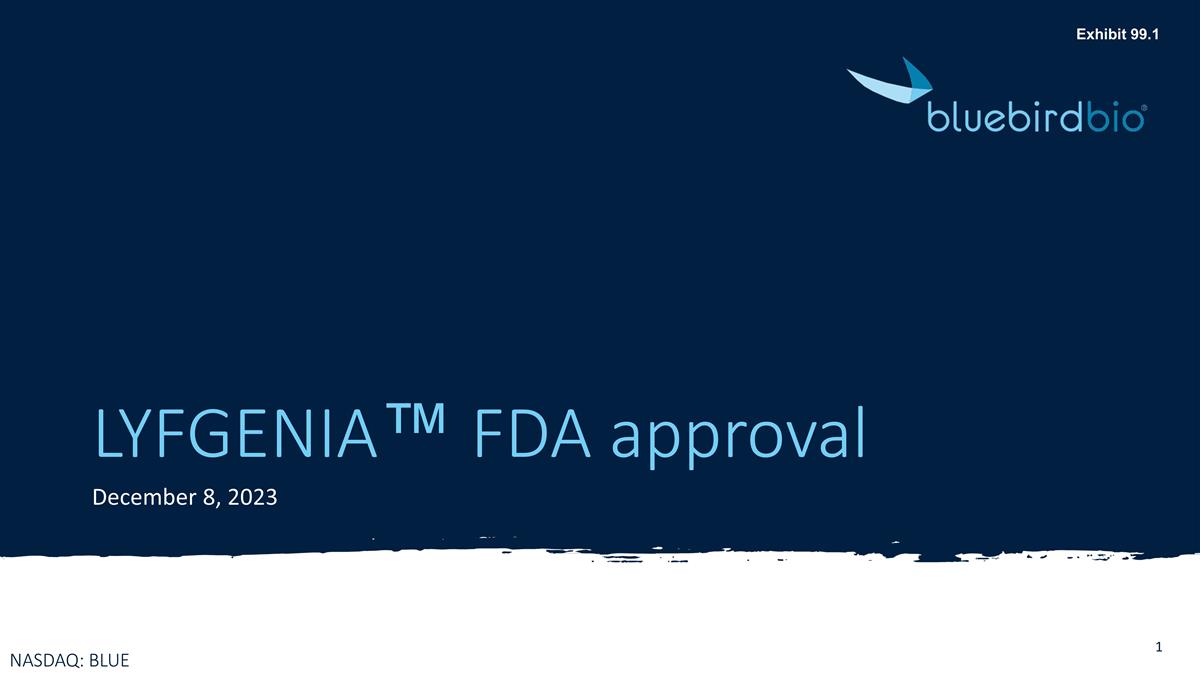
LYFGENIA™ FDA approval December 8, 2023 NASDAQ: BLUE Exhibit 99.1
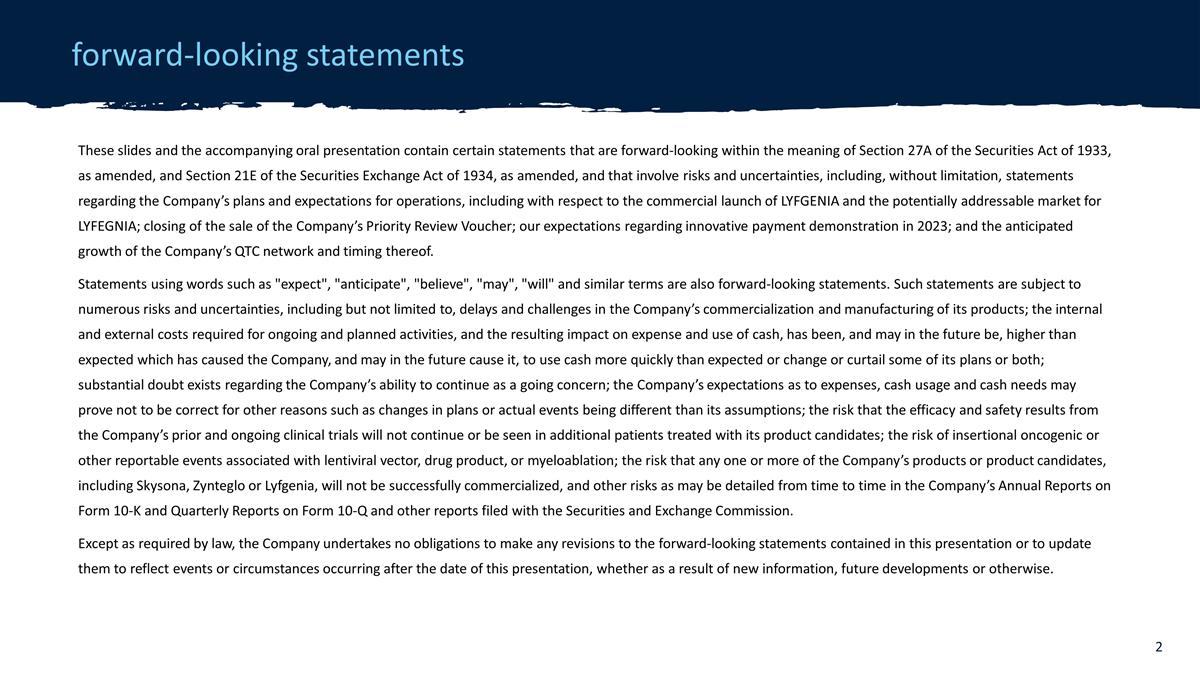
These slides and the accompanying oral presentation contain certain statements that are forward-looking within the meaning of Section 27A of the Securities Act of 1933, as amended, and Section 21E of the Securities Exchange Act of 1934, as amended, and that involve risks and uncertainties, including, without limitation, statements regarding the Company’s plans and expectations for operations, including with respect to the commercial launch of LYFGENIA and the potentially addressable market for LYFEGNIA; closing of the sale of the Company’s Priority Review Voucher; our expectations regarding innovative payment demonstration in 2023; and the anticipated growth of the Company’s QTC network and timing thereof. Statements using words such as "expect", "anticipate", "believe", "may", "will" and similar terms are also forward-looking statements. Such statements are subject to numerous risks and uncertainties, including but not limited to, delays and challenges in the Company’s commercialization and manufacturing of its products; the internal and external costs required for ongoing and planned activities, and the resulting impact on expense and use of cash, has been, and may in the future be, higher than expected which has caused the Company, and may in the future cause it, to use cash more quickly than expected or change or curtail some of its plans or both; substantial doubt exists regarding the Company’s ability to continue as a going concern; the Company’s expectations as to expenses, cash usage and cash needs may prove not to be correct for other reasons such as changes in plans or actual events being different than its assumptions; the risk that the efficacy and safety results from the Company’s prior and ongoing clinical trials will not continue or be seen in additional patients treated with its product candidates; the risk of insertional oncogenic or other reportable events associated with lentiviral vector, drug product, or myeloablation; the risk that any one or more of the Company’s products or product candidates, including Skysona, Zynteglo or Lyfgenia, will not be successfully commercialized, and other risks as may be detailed from time to time in the Company’s Annual Reports on Form 10-K and Quarterly Reports on Form 10-Q and other reports filed with the Securities and Exchange Commission. Except as required by law, the Company undertakes no obligations to make any revisions to the forward-looking statements contained in this presentation or to update them to reflect events or circumstances occurring after the date of this presentation, whether as a result of new information, future developments or otherwise. forward-looking statements
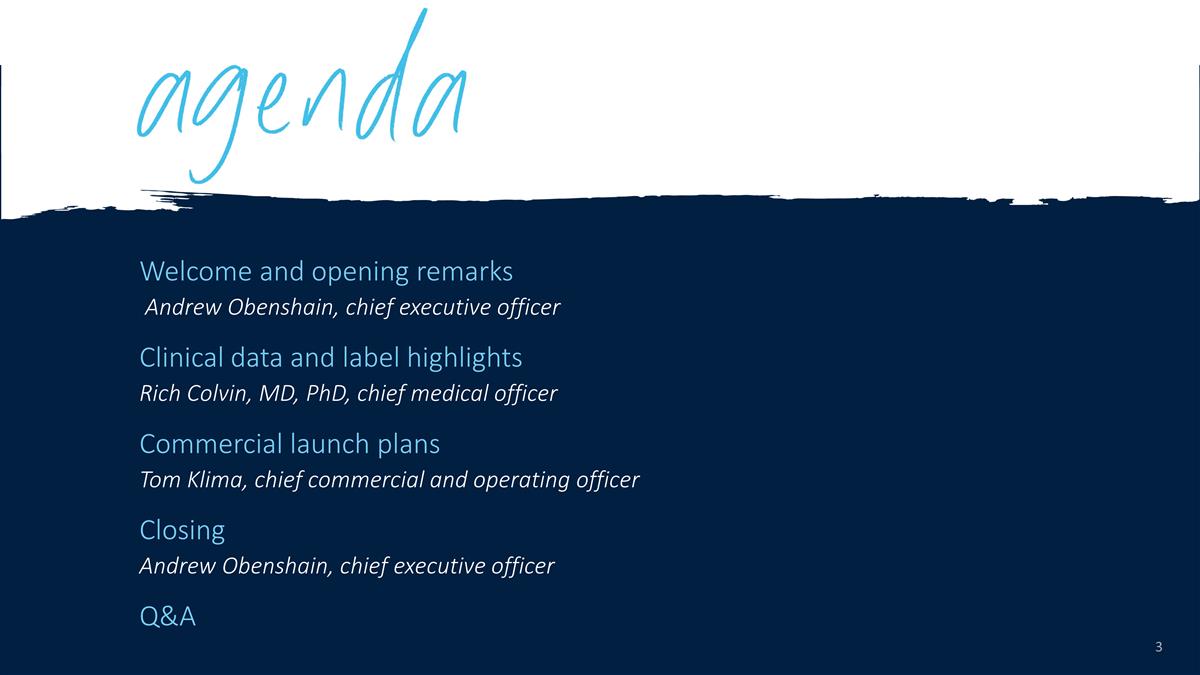
Welcome and opening remarks Andrew Obenshain, chief executive officer Clinical data and label highlights Rich Colvin, MD, PhD, chief medical officer Commercial launch plans Tom Klima, chief commercial and operating officer Closing Andrew Obenshain, chief executive officer Q&A
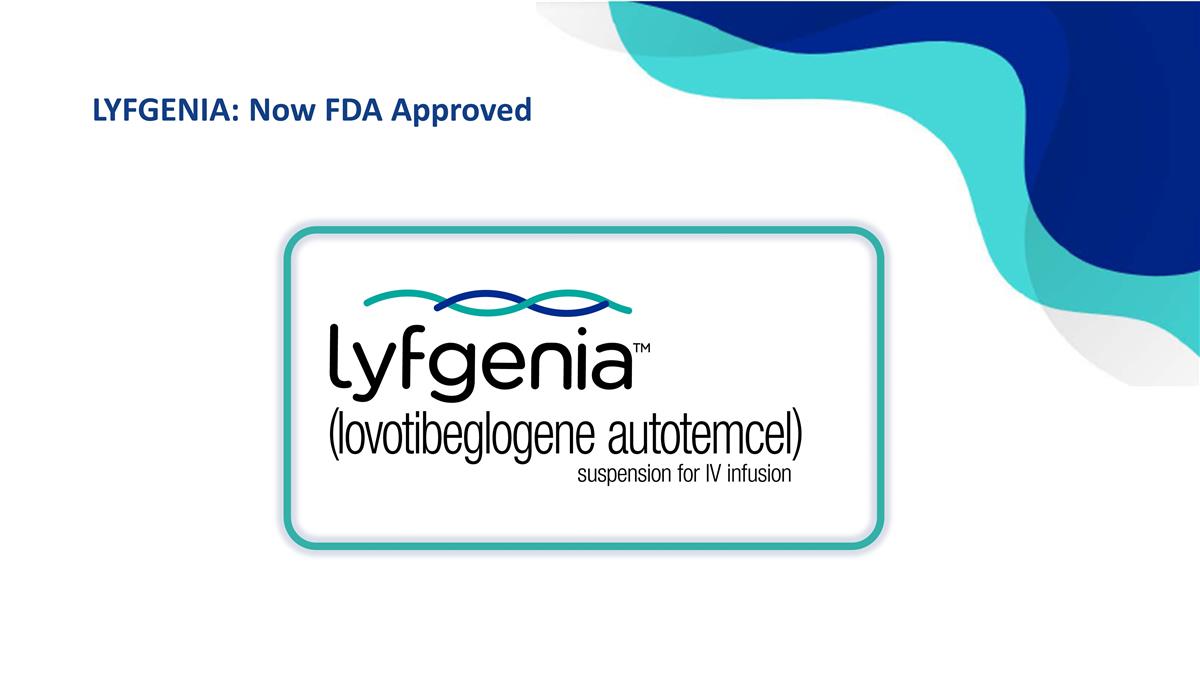
LYFGENIA: Now FDA Approved
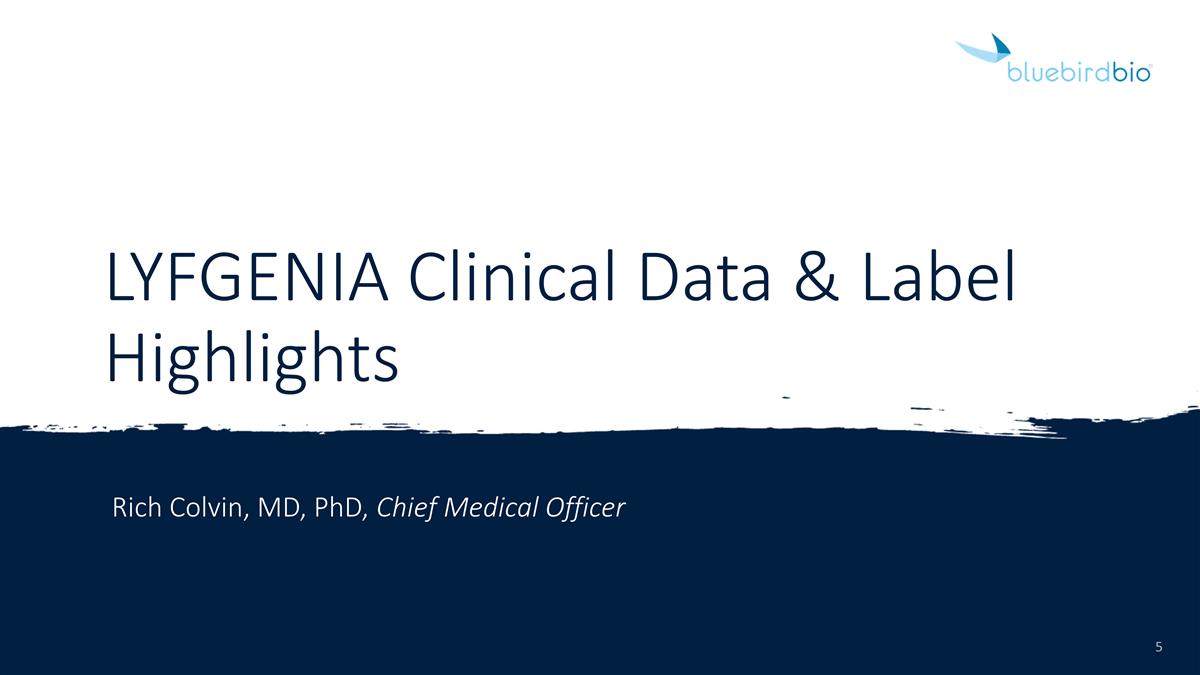
LYFGENIA Clinical Data & Label Highlights Rich Colvin, MD, PhD, Chief Medical Officer
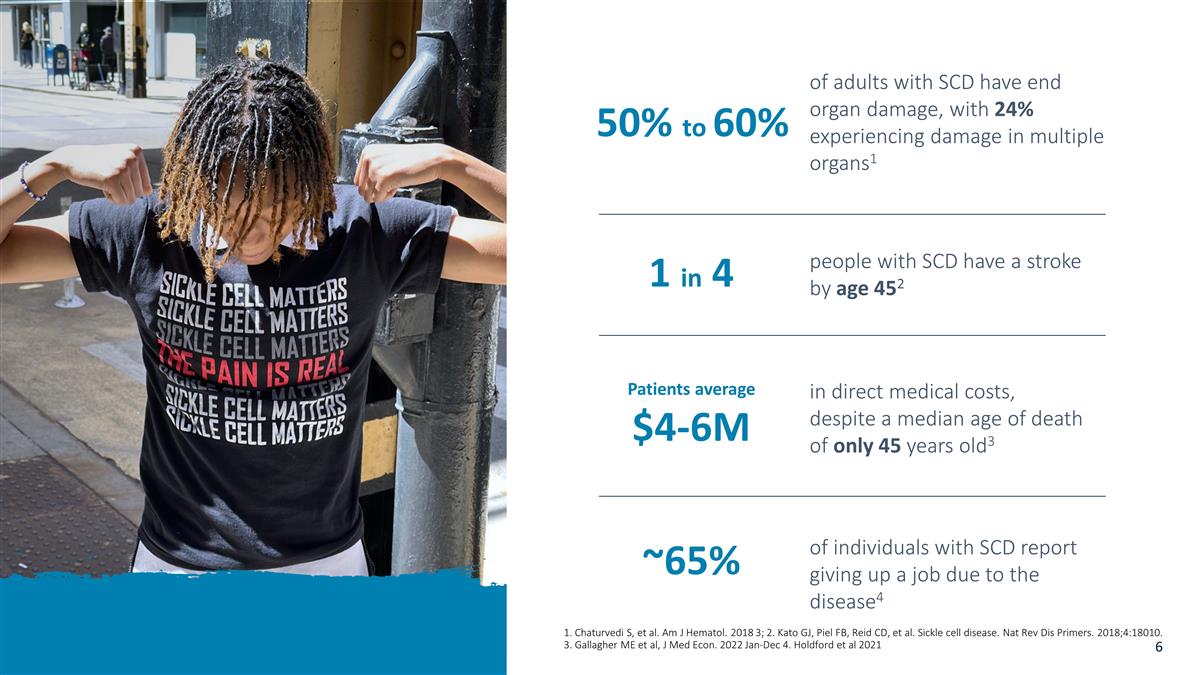
of adults with SCD have end organ damage, with 24% experiencing damage in multiple organs1 1 in 4 in direct medical costs, despite a median age of death of only 45 years old3 of individuals with SCD report giving up a job due to the disease4 1. Chaturvedi S, et al. Am J Hematol. 2018 3; 2. Kato GJ, Piel FB, Reid CD, et al. Sickle cell disease. Nat Rev Dis Primers. 2018;4:18010. 3. Gallagher ME et al, J Med Econ. 2022 Jan-Dec 4. Holdford et al 2021 people with SCD have a stroke by age 452 Patients average $4-6M ~65% 50% to 60%
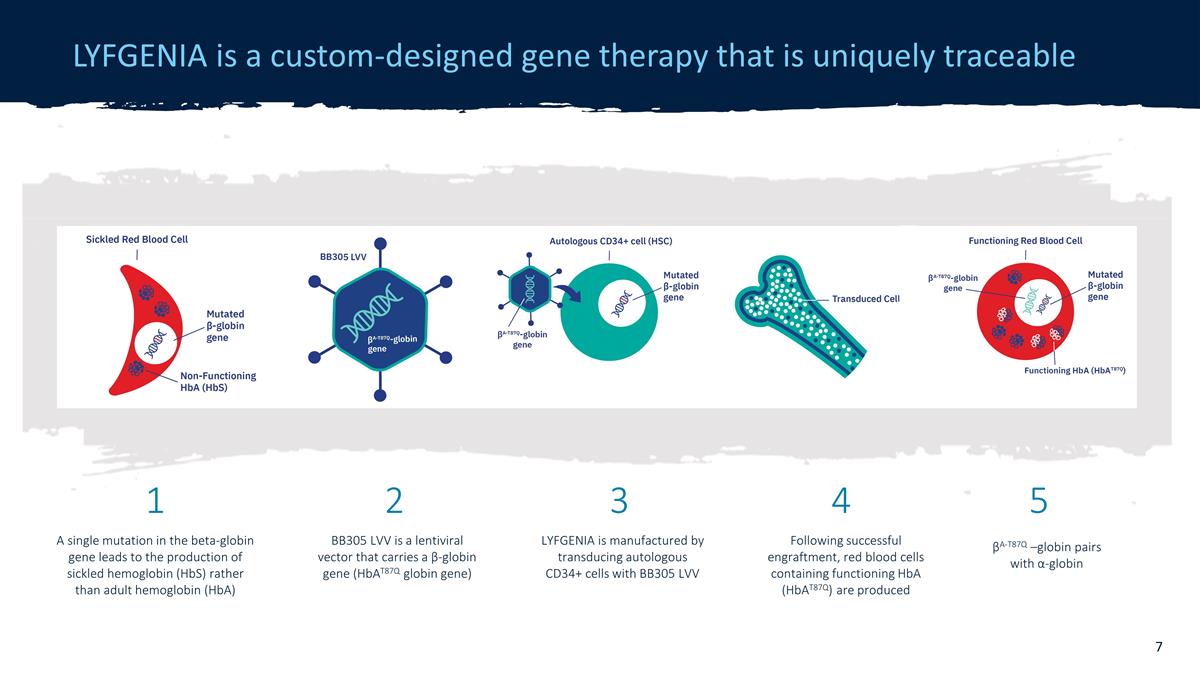
LYFGENIA is a custom-designed gene therapy that is uniquely traceable A single mutation in the beta-globin gene leads to the production of sickled hemoglobin (HbS) rather than adult hemoglobin (HbA) LYFGENIA is manufactured by transducing autologous CD34+ cells with BB305 LVV βA-T87Q –globin pairs with α-globin Following successful engraftment, red blood cells containing functioning HbA (HbAT87Q) are produced BB305 LVV is a lentiviral vector that carries a β-globin gene (HbAT87Q globin gene) 1 2 3 4 5
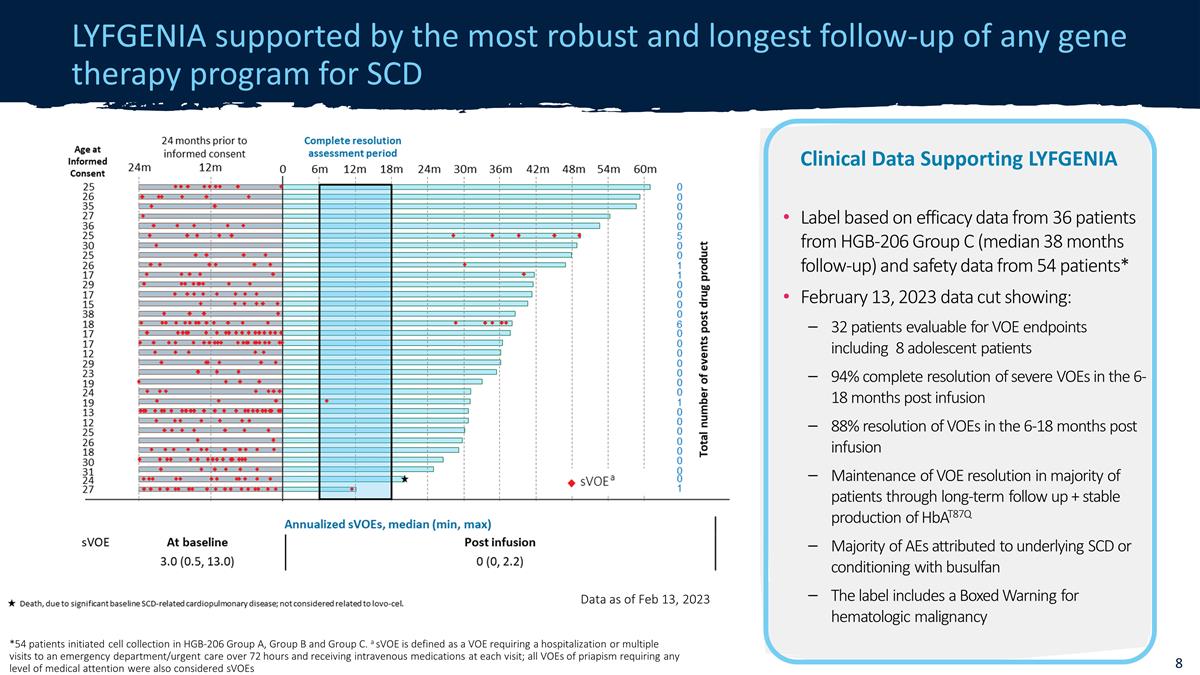
LYFGENIA supported by the most robust and longest follow-up of any gene therapy program for SCD Data as of Feb 13, 2023 *54 patients initiated cell collection in HGB-206 Group A, Group B and Group C. a sVOE is defined as a VOE requiring a hospitalization or multiple visits to an emergency department/urgent care over 72 hours and receiving intravenous medications at each visit; all VOEs of priapism requiring any level of medical attention were also considered sVOEs Clinical Data Supporting LYFGENIA Label based on efficacy data from 36 patients from HGB-206 Group C (median 38 months follow-up) and safety data from 54 patients* February 13, 2023 data cut showing: 32 patients evaluable for VOE endpoints including 8 adolescent patients 94% complete resolution of severe VOEs in the 6-18 months post infusion 88% resolution of VOEs in the 6-18 months post infusion Maintenance of VOE resolution in majority of patients through long-term follow up + stable production of HbAT87Q Majority of AEs attributed to underlying SCD or conditioning with busulfan The label includes a Boxed Warning for hematologic malignancy
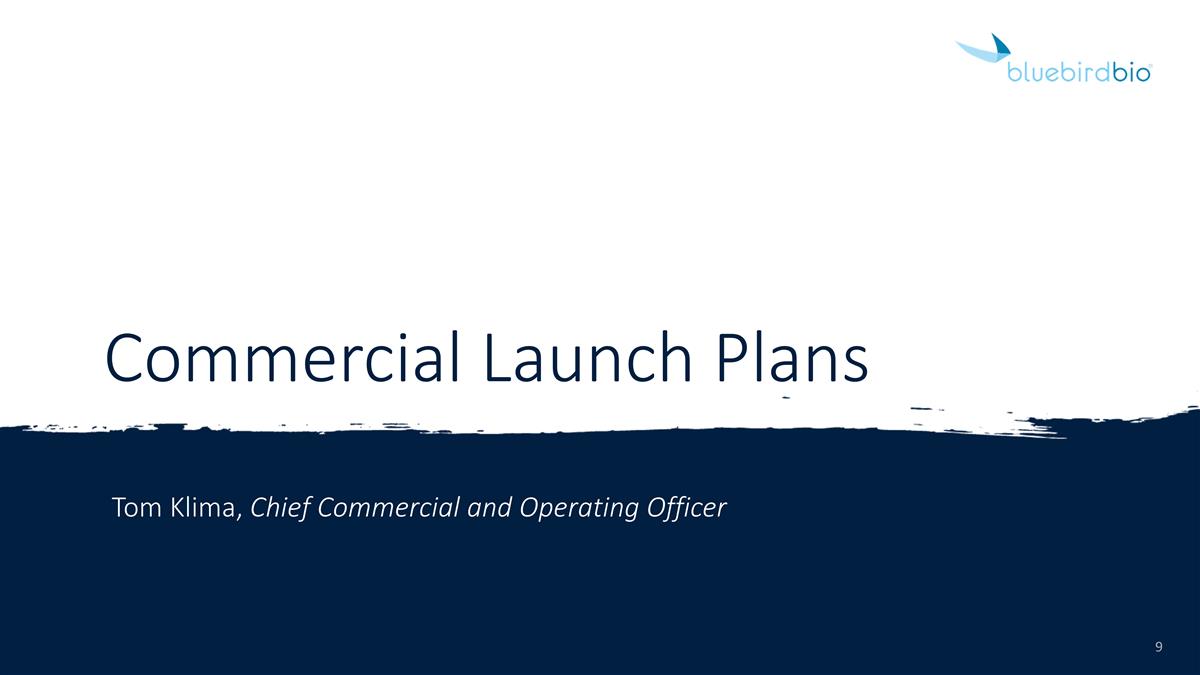
Commercial Launch Plans Tom Klima, Chief Commercial and Operating Officer
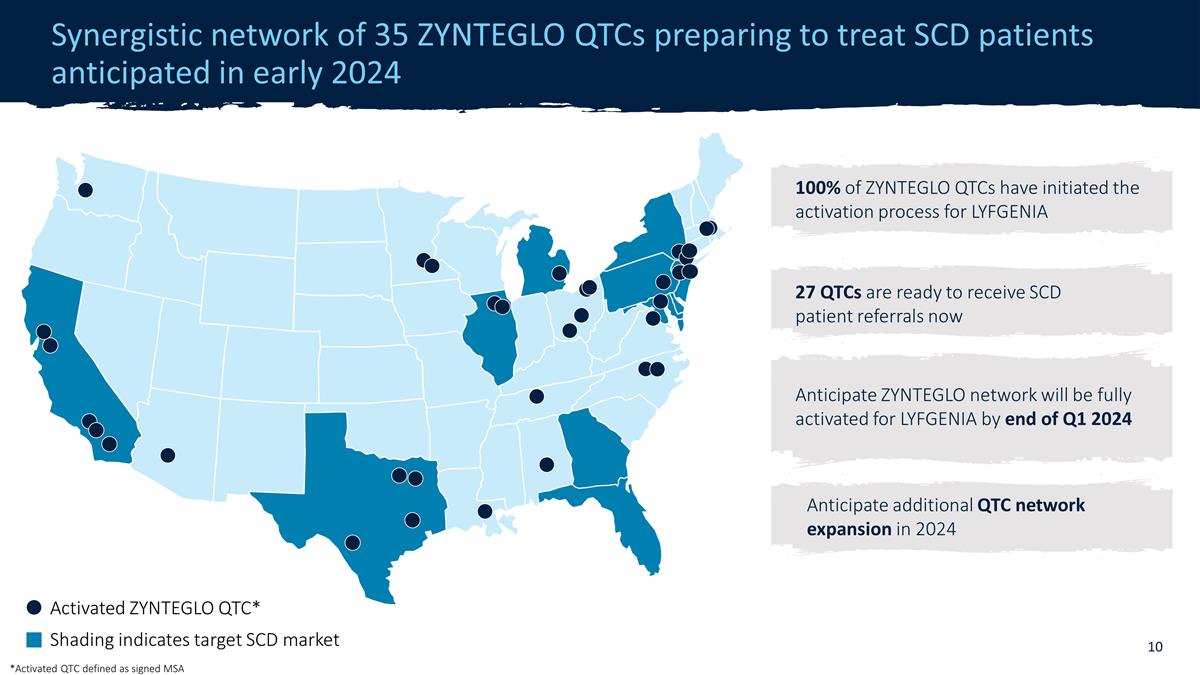
Synergistic network of 35 ZYNTEGLO QTCs preparing to treat SCD patients anticipated in early 2024 27 QTCs are ready to receive SCD patient referrals now Activated ZYNTEGLO QTC* Shading indicates target SCD market Anticipate additional QTC network expansion in 2024 100% of ZYNTEGLO QTCs have initiated the activation process for LYFGENIA Anticipate ZYNTEGLO network will be fully activated for LYFGENIA by end of Q1 2024 *Activated QTC defined as signed MSA
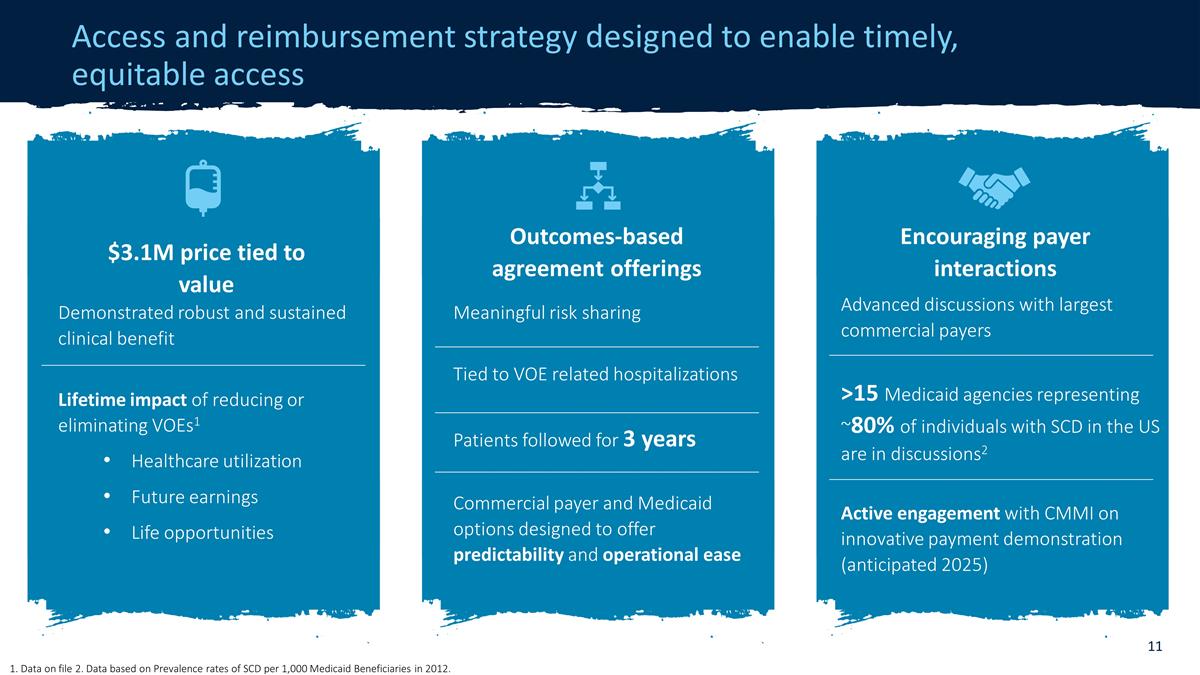
Access and reimbursement strategy designed to enable timely, equitable access Advanced discussions with largest commercial payers >15 Medicaid agencies representing ~80% of individuals with SCD in the US are in discussions2 Active engagement with CMMI on innovative payment demonstration (anticipated 2025) Encouraging payer interactions Demonstrated robust and sustained clinical benefit Lifetime impact of reducing or eliminating VOEs1 Healthcare utilization Future earnings Life opportunities $3.1M price tied to value Meaningful risk sharing Tied to VOE related hospitalizations Patients followed for 3 years Commercial payer and Medicaid options designed to offer predictability and operational ease Outcomes-based agreement offerings 1. Data on file 2. Data based on Prevalence rates of SCD per 1,000 Medicaid Beneficiaries in 2012.
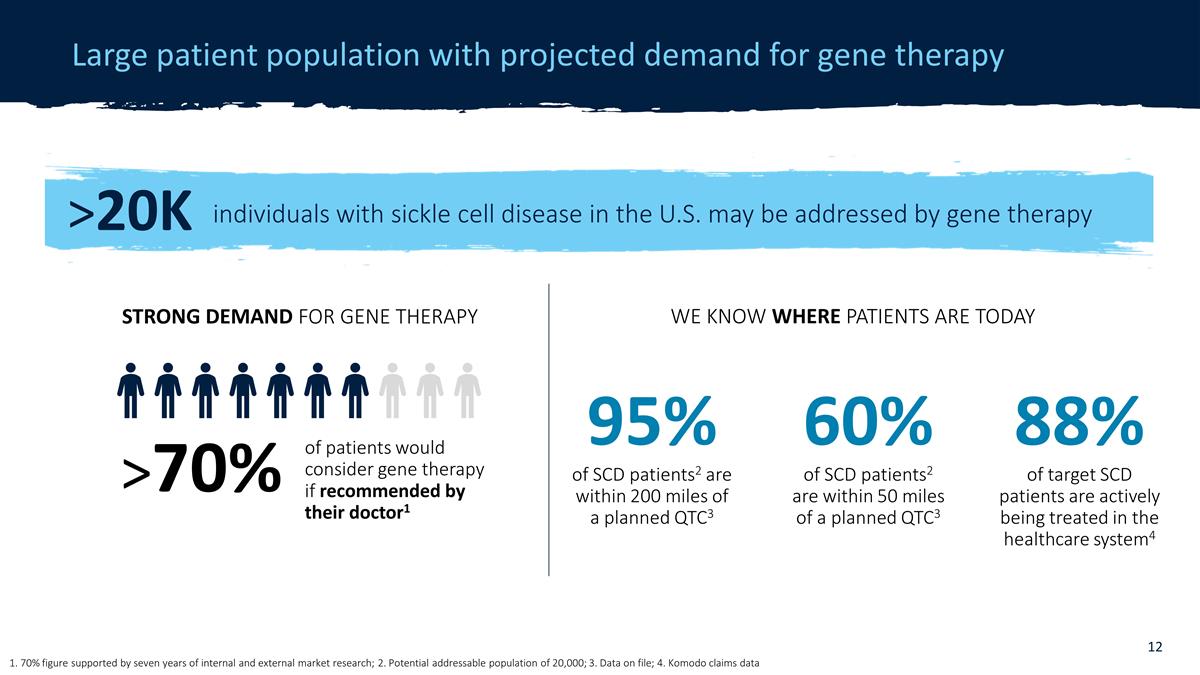
Large patient population with projected demand for gene therapy 1. 70% figure supported by seven years of internal and external market research; 2. Potential addressable population of 20,000; 3. Data on file; 4. Komodo claims data >20K individuals with sickle cell disease in the U.S. may be addressed by gene therapy of patients would consider gene therapy if recommended by their doctor1 >70% STRONG DEMAND FOR GENE THERAPY WE KNOW WHERE PATIENTS ARE TODAY 60% of SCD patients2 are within 50 miles of a planned QTC3 95% of SCD patients2 are within 200 miles of a planned QTC3 88% of target SCD patients are actively being treated in the healthcare system4
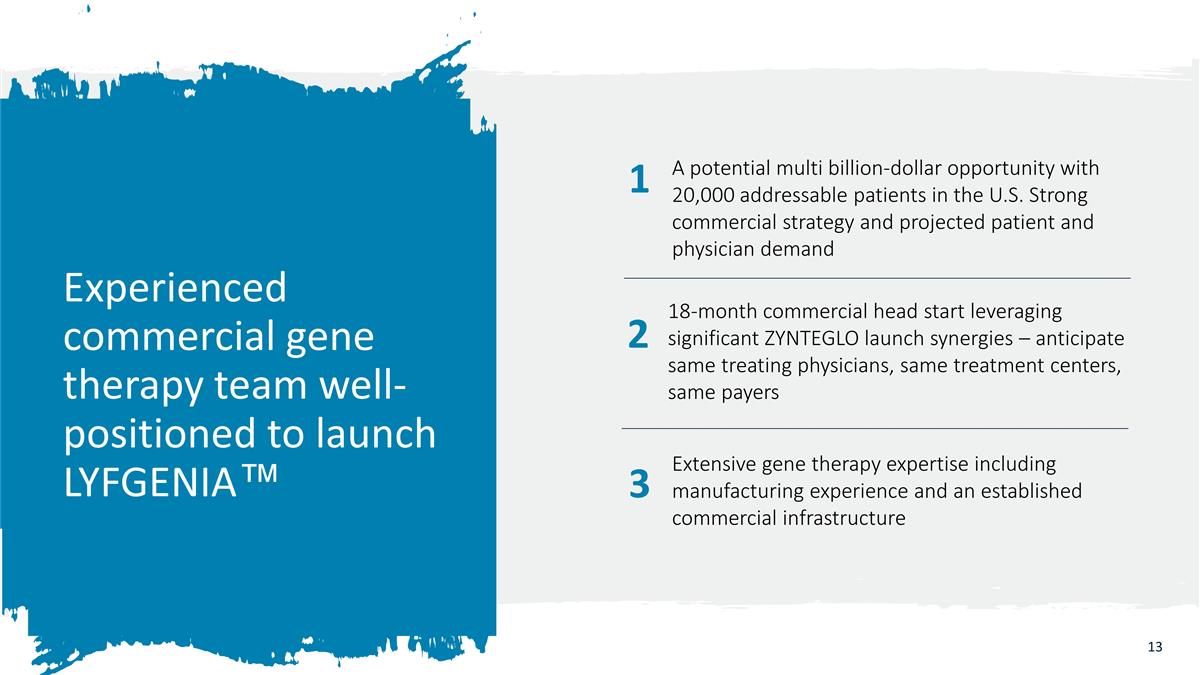
2 A potential multi billion-dollar opportunity with 20,000 addressable patients in the U.S. Strong commercial strategy and projected patient and physician demand Experienced commercial gene therapy team well-positioned to launch LYFGENIA™ 18-month commercial head start leveraging significant ZYNTEGLO launch synergies – anticipate same treating physicians, same treatment centers, same payers 1 3 Extensive gene therapy expertise including manufacturing experience and an established commercial infrastructure
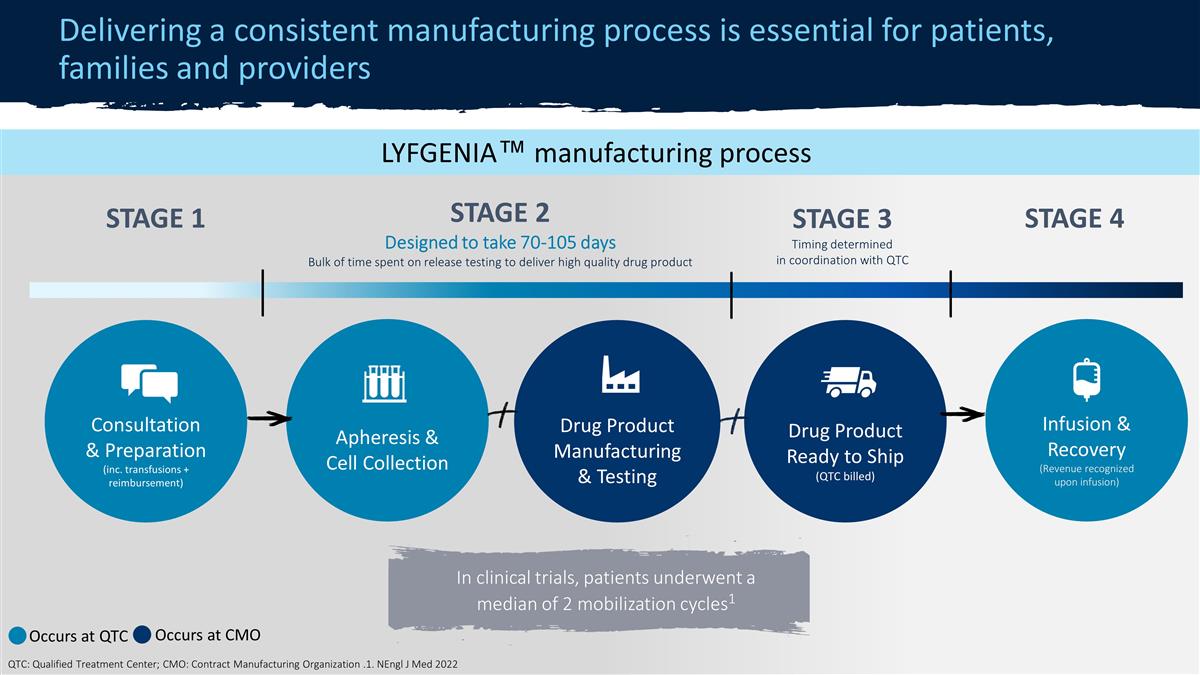
ZYNTEGLO® manufacturing process Delivering a consistent manufacturing process is essential for patients, families and providers STAGE 2◇ 70-90 days Bulk of time spent on release testing to deliver high quality drug product Apheresis & Cell Collection Drug Product Manufacturing & Testing Drug Product Ready to Ship (QTC billed) Infusion & Recovery (Revenue recognized upon infusion) Consultation & Preparation (inc. hyper transfusions + reimbursement confirmation) STAGE 1* STAGE 3* *Occurs at QTC ◇ Occurs at CMO QTC: Qualified Treatment Center; CMO: Contract Manufacturing Organization In clinical trials, recollections occurred in approximately 20% of cases. In commercial setting, all patients have [completed] the treatment process following recollection. LYFGENIA™ manufacturing process STAGE 2 Designed to take 70-105 days Bulk of time spent on release testing to deliver high quality drug product Apheresis & Cell Collection Drug Product Manufacturing & Testing Drug Product Ready to Ship (QTC billed) Infusion & Recovery (Revenue recognized upon infusion) Consultation & Preparation (inc. transfusions + reimbursement) STAGE 1 STAGE 4 In clinical trials, patients underwent a median of 2 mobilization cycles1 Occurs at QTC Occurs at CMO QTC: Qualified Treatment Center; CMO: Contract Manufacturing Organization .1. NEngl J Med 2022 STAGE 3 Timing determined in coordination with QTC
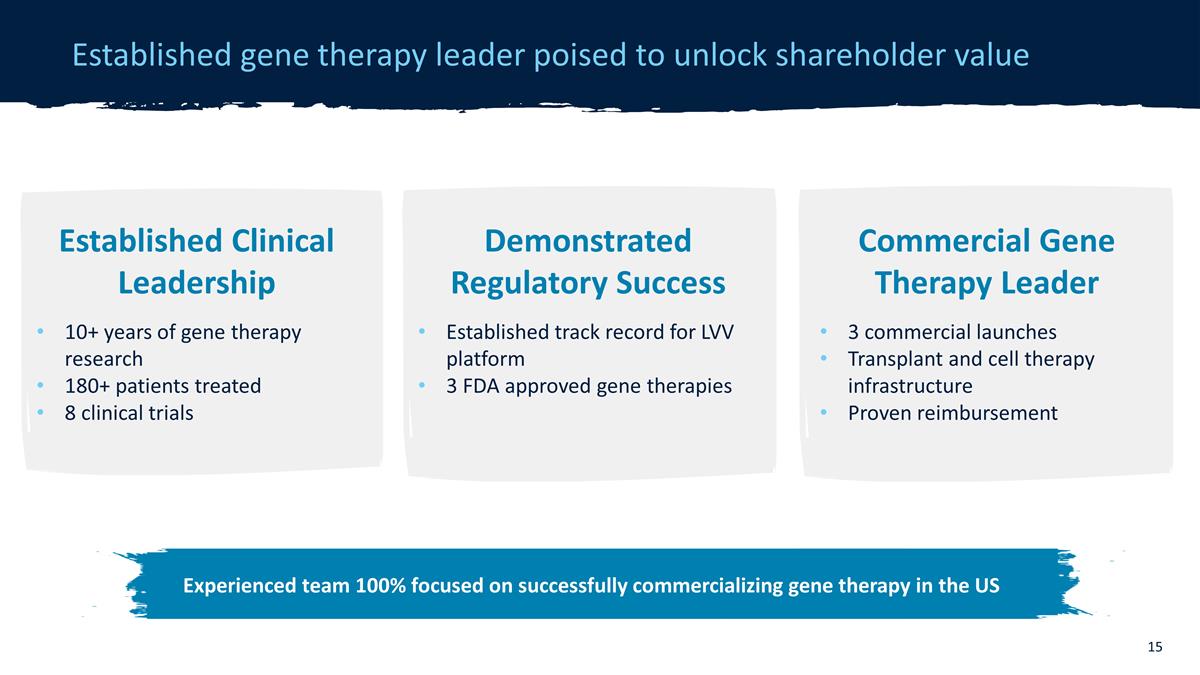
Established gene therapy leader poised to unlock shareholder value Established Clinical Leadership 10+ years of gene therapy research 180+ patients treated 8 clinical trials Experienced team 100% focused on successfully commercializing gene therapy in the US Demonstrated Regulatory Success Established track record for LVV platform 3 FDA approved gene therapies Commercial Gene Therapy Leader 3 commercial launches Transplant and cell therapy infrastructure Proven reimbursement
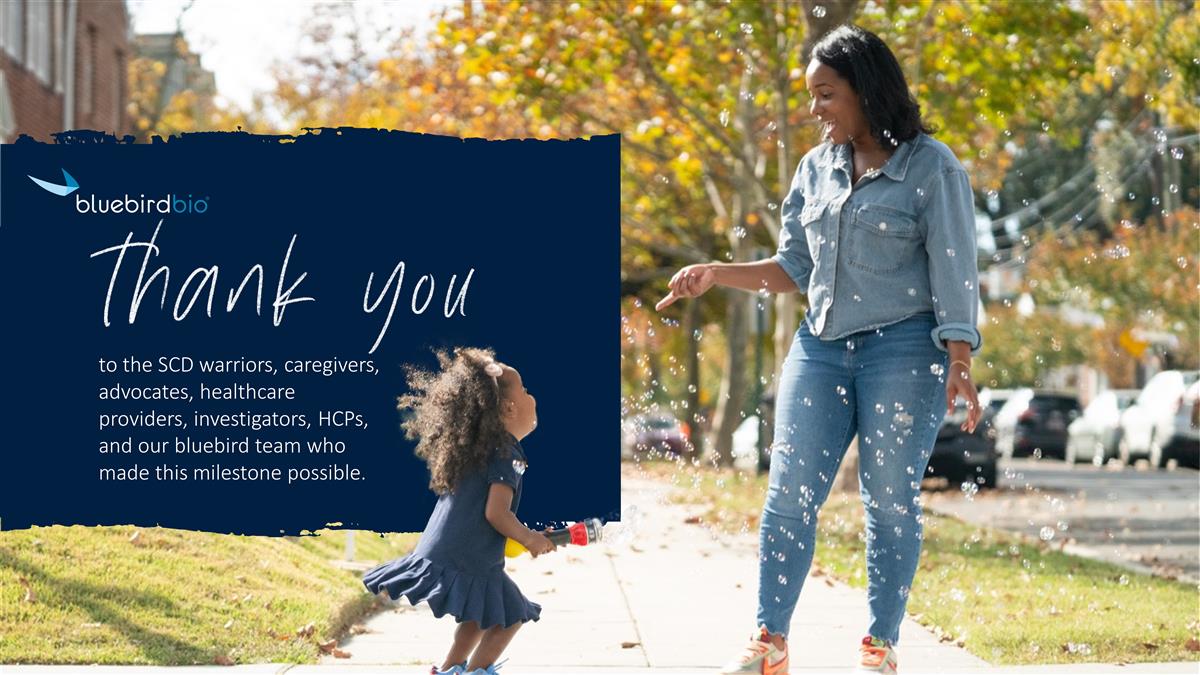
to the SCD warriors, caregivers, advocates, healthcare providers, investigators, HCPs, and our bluebird team who made this milestone possible.
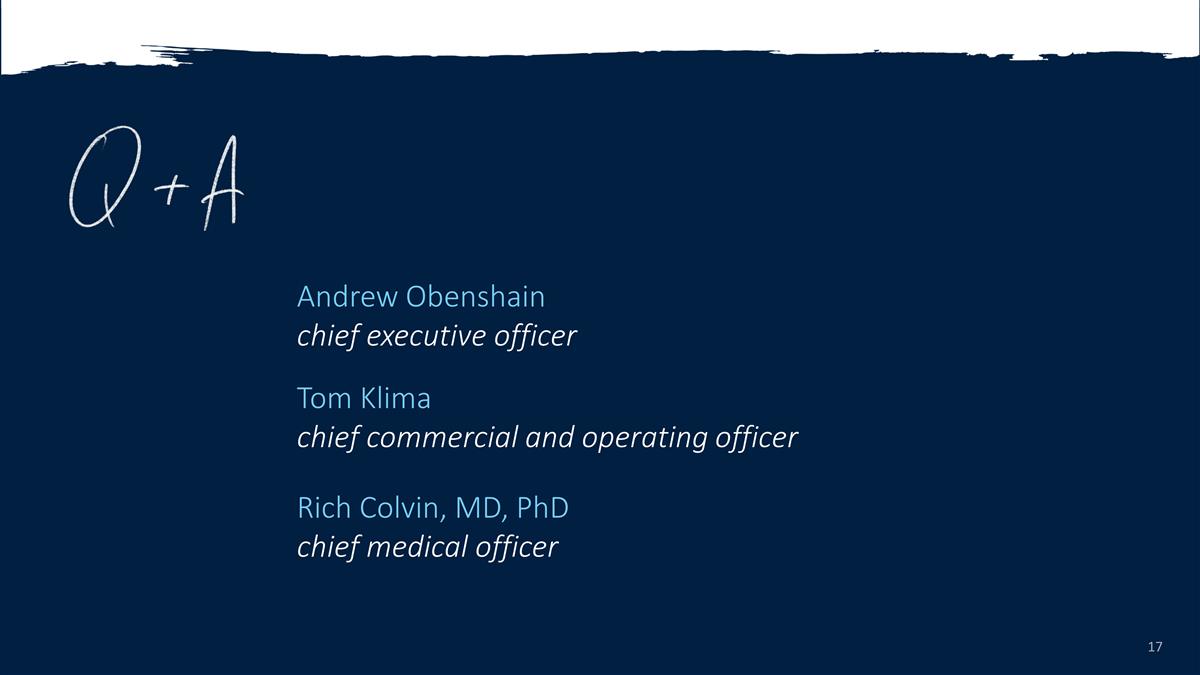
Rich Colvin, MD, PhD chief medical officer Andrew Obenshain chief executive officer Tom Klima chief commercial and operating officer